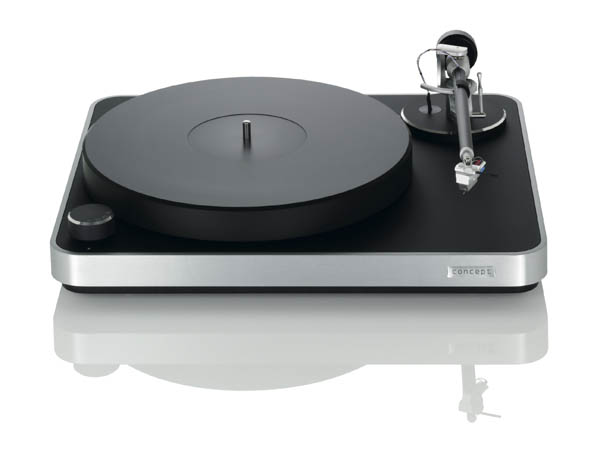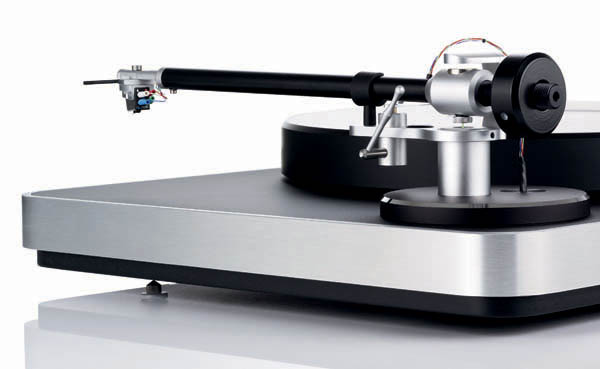|
You are reading the older HTML site
Positive Feedback ISSUE 67
The Neoteric Listener and the Clearaudio Concept
Turntable
Still no turntable? Are you looking at all those tantalizing album releases, and wondering why the heck you keep putting off buying a new turntable to replace the old one that belonged to a different you? After all, for most of us, the audio journey started in our favorite record store, flipping through albums, and lusting after a system par excellence to transport us to musical places of Spanish castle magic (A-Side and B-Side). After reading Michael Mercer's wonderful review of the VPI Traveler, I've definitely caught his needlemania. This poses a problem, however, because my previous turntable was donated to local rockers who trashed it beyond recognition (who would've guessed drummers could be so destructive?). Fortunately, PF colleague, Danny Kaey, steered me towards the Clearaudio Concept turntable as a great way to start: "It's composed of solid materials, precisely made by a German company [spoken like a true former resident of Austria], what more could you ask for?" I could ask for the delivery man to hurry the heck up! The rain is pounding like rusty nails on my shack's tin awning, and I'm patiently waiting for a shipping truck to deliver the Clearaudio Concept turntable review sample. I know it's allegedly on the way because I can see the little entries in the tracking update. I'm looking out of the window every ten minutes to make sure that nobody leaves it on the porch to become as waterlogged as a kid's soccer ball in a storm. Nine hours later, and still, still no blasted turntable! Mind you, it's not as if I haven't already been waiting for years, all platter and no matter, wondering if the whole vinyl thing is like a nostalgic ride in a 1930 Packard roadster: fun on Sunday morning, rough and noisy every time else. What's more, I'm probably not alone in being a little intimidated by the shifting challenges needed to be a member of the audiophile Hall of Records. Vinyl veterans may scoff, but few initiations are as thank-you-sir-may-I-have-another as buying your first turntable. Some experts say spending anything less than ten grand (or twenty, or fifty, or a hundred) is a waste of money. Others say that anyone who doesn't buy a vintage table modded by such-and-such tech meister is a damned fool. "Oh, the cheap turntables are too plasticky" or "The viscous damping ones are too gooey!" "Don't even ask about direct drive vs. belt drive... or cartridges...or VTA." ...Or a billion other things analog diehards are ready to dog-fight over. Still, when big kahunas like Danny Kaey, Michael Mercer, and even computer audio G-man Pete Davey have gone to the dark (vinyl) side, who am I to resist the call, especially when the Concept turntable seems to be so much fun for all audio ages? Vinyl, more than any other medium, never bothers to pretend that you're hearing a live performance. Every tick, pop, and pitch fluctuation (which the ear detects in even the best turntables) lowers the fourth wall and reminds the listener that, though the performance is a recording, the listening experience is real. The recording itself is the performance, and the choice of musicians, studio effects, even the arrangement of tracks and closing songs express the transcendent artistry of those who understand what it means to "make a great record." A playlist or shuffle session is loads of fun, but it ain't a masterpiece. OK, it's eight thirty on Christmas Eve, and no package. The dang thing just isn't coming! And it didn't, but the delivery that wasn't cannot be blamed on Clearaudio or its U.S. distributor, Musical Surroundings. Nope, they did everything but carry the darn thing to my door to get it here. The turntable vanished like cookies and cognac left for Santa. Somewhere, I imagine that there's an expertly set up Concept turntable and Clearaudio Concept moving coil cartridge scratching out a torrid beat at a back yard rave. Or maybe it's sitting on an audiophile's rack at a too-good-to be true price (don't be surprised if the karma makes it skip). As good fortune would have it, however, besides being a major U.S. distributor, Musical Surroundings are decent chaps, and they kindly sent yet another Clearaudio Concept that did arrive without mishap. This one shipped with their new Clearaudio Virtuoso V2 Ebony cartridge that Joe Wessling of Musical Surroundings thought would sound very nice with the Ray Samuels F-117 Nighthawk phono stage that I am using. As it turns out, the man knows his business! Of course, you can order this turntable with the Concept MM cartridge pre-installed, but Musical Surroundings is very pleased with the new V2 Ebony cartridge, and I can see why. The Virtuoso V2 Ebony cartridge runs for $900, but when ordered with the Concept, the price drops to $810 (this cartridge does not come pre-installed). Musical Surroundings was also kind enough to include a Concept record clamp ($125), a carbon fiber record brush ($35) and an Elixir of Sound stylus cleaner ($30). All of the aforementioned products worked beautifully, and I would consider all them to be essential, so budget accordingly. Geez, it's finally here, now what do I do?
Nothing symbolizes the Clearaudio Concept better than the Clearaudio Smart Stylus force gauge, which is simple to use and works great. It's a flat sliver of aluminum with two little feet that you use to set the tracking force. The Concept ships with the turntable chassis, tonearm, and cartridge already installed and set for best performance. The only thing the customer needs to do is set the platter in place and level it by adjusting the turntable's feet, remove some tape securing the tonearm and cartridge, and check to make sure that the stylus force gauge has not been altered by the jostling of shipping. Joe Wessling describes the Smart Stylus operation: "You will see the number 2.5 printed on it next to one of the lines. This will be the tracking force ideal. I would place the gauge around the first 1/3 to half way across and see what you get. The gauge should ideally "level" itself like a teeter totter. If it's too light, then the side the stylus is on will not go down and if it's too heavy, vice versa. Pretty simple. And fairly accurate. You can always add or subtract force via ear [by turning the counterweight located at the end of the tonearm]. The rest of the alignment should be right on. And the only thing you'll need to do is check the tracking force. Every Concept comes with this Smart Stylus gauge." The whole process takes about fifteen minutes to get you spinning your records. That, in itself, makes the Concept an extremely attractive turntable option. Like the stylus on the teeter-totter gauge, there is a tipping point for the consumer where all the bewildering math and science needed to get most turntables running is too much of a hassle. The Concept turntable counters all that by being easy to use, easily sited in any stand, and backed by an industry leader with an established track record for reliability. There's nothing cheap, plasticky, or gooey about this turntable, just great analog sound. In fact it's the kind of sound you remember from the past, but probably much, much better.
Wait a minute! I thought Double DSD was the new Audio El Dorado? I've been fortunate to hear direct comparisons of many recordings played via a twenty grand turntable versus a state of the art double DSD capable player, and, yes, it's pretty clear to me that this newest digital medium delivers more music. Period. Maybe one of those Clearaudio Statements or Walker Audio Proscenium Black Diamond V masterpieces would change my mind, but I don't think so. Digital audio will continue to expand and recontextualize the recorded listening experience in a number of ways, but that phenomenon won't mean a damn to those who love playing records. Records are fun; computer files are functional. Someday, there will be a huge catalog of music on double DSD, but I can find all of that, and much more, right now on vinyl. There may be a world of digital files, but they won't include my 1977 radio interview promo record with a wearily acerbic Don Henley and Glen Frey, or the creaky 1958 mono 10" long player of Songs by Tom Lehrer on Decca Records. For sure, there's no download of the notorious Top Jimmy and the Rhythm Pigs's Pigus Drunkus Maximus. I'm sure you have plenty of Double-A league records like these that are are always collectible, but rarely downloadable. Also, while some pundits claim that, at their best, analog and digital are fairly close, that hasn't been my experience. It would be more accurate to say that both can make wonderful, but very different, sounding music for the potential listener. For my part, the Concept's sound is warm, punchy, and engaging compared to the computer audio and compact discs that I usually listen to. Paired with Peachtree Audio iNova and Nola Contenders, the Concept couldn't be more satisfyingly full. An encyclopedic line-by-line auditing of the Concept's sound vis-a-vis other turntables at this range is beyond my scope (for now), so check with the Musical Surroundings website for that. The website also details the main features:
The simplicity and lovely sound of this turntable is all anyone needs to enjoy the visceral and tactile pleasures of playing a record. Since the Concept arrived, I've been scouring the record swap meets and garage sales looking for $1 gems and trying to avoid the fool's gold. In earlier reviews, I've raved about the Analogue Productions label releases because everything about them––the work of art album covers, the solidly reassuring vinyl weight, the near absence of background noise––makes me set up and holler whenever there's a new delivery. The Clearaudio Concept's handling of Phoebe Snow sounds so good, I'm playing Phoebe Snow (never, ever thought that would happen). Deer Tick's "Goodbye, Dear Friend" from The Black Dirt Sessions conveys amazing atmosphere of depth and space, and the instruments seem to be much more integrated than I'm used to hearing from the CD version (which sounds like a collage by comparison). The digital version has a wider soundstage and clearer (artificial?) articulation of each instrument, but, oh that stridency!
At least, that's how it seems to me now that I've heard how smooth and natural a good turntable can sound. Similarly, the Concept not only delivers thrilling harmonica runs on Sonny Boy Williamson's "The Sky is Crying" from Keep it to Ourselves, but also has no trouble conveying the quiet, lovely articulation of each breath during the stops. Sonny Boy William's voice has a resonant, distinctly human timbre--no pro tools here. Singing a single word, you hear the full spectrum the vocal: the broad warmth of the lower note that breaks into a rasp as the higher inflection moves up the throat, and finally the nasal stop at the end as the breath is cut back. Throughout the album, the interplay between acoustic guitar, harmonica, and voice never seems anything but natural. "Is it So Strange" from the Essential Elvis Vol. 2 45 RPM is pure, unadulterated King. On this song, the Concept's midband prowess displays Elvis's vocal purity at its best, while "It Is No Secret" (What God Can Do) delivers the Jordanaire's iconic blend of distinct voices unified in commanding power. Moving forward a couple of decades and across a few planes of existence, the Concepts handling of instruments on "China Doll" from Grateful Dead's Reckoning proves that the magnificent sound of Jerry Garcia's spidery guitar and the mesmerizing bass playing of Phil Lesh can only be fully appreciated by hearing it on vinyl. Returning to the world of records via the Clearaudio Concept turntable is a homecoming to music presented as a tactile, impressionistic, even cinematic embodiment of the recording arts. Since It's arrival, I've had more fun listening to music than I have in years. Now what? Buy one, it's highly recommended!
Clearaudio Concept Turntable
w/pre-installed Concept MM cartridge Cartridge Used for the Column:
Clearaudio Virtuoso V2 Ebony
cartridge Clearaudio www.clearaudio.de/index_en.php Musical Surroundings
|




